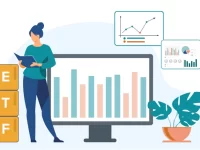Cash Forecasting: Techniques, Best Practices, and Software Options

Every successful business needs to know where its money is going—and where it’s coming from. One of the best ways to do that is with cash flow forecasting. This is a method used to estimate the cash that will move in and out of your business during a certain period.
With a reliable forecast, your team can make better decisions, plan ahead with confidence, and avoid cash shortages. It also helps identify the best time to invest extra funds or prepare for slow seasons.
Why Cash Flow Forecasting Is Essential for Growth
The business world is always shifting. Conditions change, markets move quickly, and challenges often arrive without warning. That’s why having a clear picture of your financial future is so important.
Here are a few examples where forecasting makes a difference:
- A recession might lower sales, but it could also reduce costs like advertising.
- A supply chain issue might raise your expenses almost overnight.
- Interest rate shifts could help or hurt your borrowing power.
- Industry changes could cause your stock price to rise or fall sharply.
- A disaster like a fire or storm could shut down operations for weeks.
Cash flow forecasting allows you to react with facts instead of guesses. It supports smart scenario planning, helps reduce risks, and opens the door for growth opportunities—especially when your financial data is being tracked, organized, and reviewed consistently.
How Is a Cash Forecast Different From a Budget?
Although both are financial tools, a budget and a cash flow forecast have different goals.
- A budget is a plan for your income and expenses over time. It’s useful for managing projects or yearly financial targets.
- A cash forecast focuses on your actual bank balances. It helps make sure your business has enough cash available to cover bills, pay salaries, or make purchases.
Budgets are about planning where money should go. Forecasts are about tracking where cash will actually be at any moment in the future.
Best Practices for Effective Cash Forecasting
Strong cash forecasting depends on good habits. These practices can help finance teams create more useful forecasts with less effort.
1. Use the Most Accurate Data
The best forecasts start with real numbers from your bank. Linking your forecasting tools directly to financial accounts ensures up-to-date information.
2. Label Transactions Clearly
Sorting and tagging your income and expenses helps reveal how different activities affect cash flow. Many companies now use automation to simplify this step.
3. Watch Your Working Capital
Working capital is the money available for daily business operations. A good forecast will show whether your current cash can support payroll, bills, inventory, and more.
4. Plan for Multiple Scenarios
Instead of just one prediction, try building several. Think through best-case and worst-case outcomes to stay prepared for surprises.
5. Make It a Team Project
Cash forecasting works best when different people—finance managers, operations leaders, even department heads—contribute. Each brings insights that help build a more complete picture.
4 Forecasting Methods to Consider
Not every company uses the same approach. Your method depends on your business size, your goals, and the data available.
1. Straight-Line Forecasting
This method uses simple averages to predict future cash. It’s quick and easy, though not very detailed. Best for businesses with steady income and regular spending.
2. Time Series Forecasting
This approach uses past trends—like seasonal sales or cycles—to estimate future cash flow. It’s more complex but also more accurate for companies with a few years of data.
3. Qualitative Forecasting
This method mixes expert input, industry research, and past results. It’s helpful when exploring a new market or launching a new product, especially when little data exists.
4. Automated Forecasting
The most advanced method uses software and artificial intelligence to analyze real-time bank data and automatically generate forecasts. It also improves over time by learning from past trends.
Forecasting Tools: Manual vs. Automated
Spreadsheets used to be the standard for forecasting. But managing forecasts by hand often leads to errors, wasted time, and outdated results.
Here’s a comparison:
- Spreadsheets
- Manual data entry
- Prone to errors and formula mistakes
- Hard to update and share
- Time-consuming to manage
Forecasting Software
- Connects to your bank accounts directly
- Tracks income and expenses in real time
- Runs multiple future scenarios quickly
- Displays charts and reports automatically
- Saves hours of work each month
Software like Trovata helps finance teams forecast faster and with greater confidence. You can even access reports from your phone—so decisions don’t have to wait until you’re back at your desk.
Who Should Use Cash Flow Forecasting?
No matter the industry or company size, every business can benefit:
- Startups need to track spending and plan for growth.
- Retailers and hospitality groups manage seasonal income swings.
- Manufacturers plan payments across supply chains.
- Healthcare companies respond to changes in insurance and government policy.
- Private equity firms use forecasting to guide operational changes.
- Small businesses use it to stay on top of daily financial needs.
Final Thoughts: Better Forecasting, Better Business
Cash forecasting doesn’t promise perfect predictions—but it offers the next best thing. When you have clear insight into where your money is headed, you can avoid surprises and act with purpose.
Modern tools make forecasting faster, easier, and more accurate. Instead of spending hours on spreadsheets, you’ll spend time making real decisions that support your team and drive your goals forward.
If your business is ready to simplify forecasting and reduce stress, consider using tools like Trovata. It helps teams automate cash tracking, run what-if scenarios, and save time while improving accuracy.






